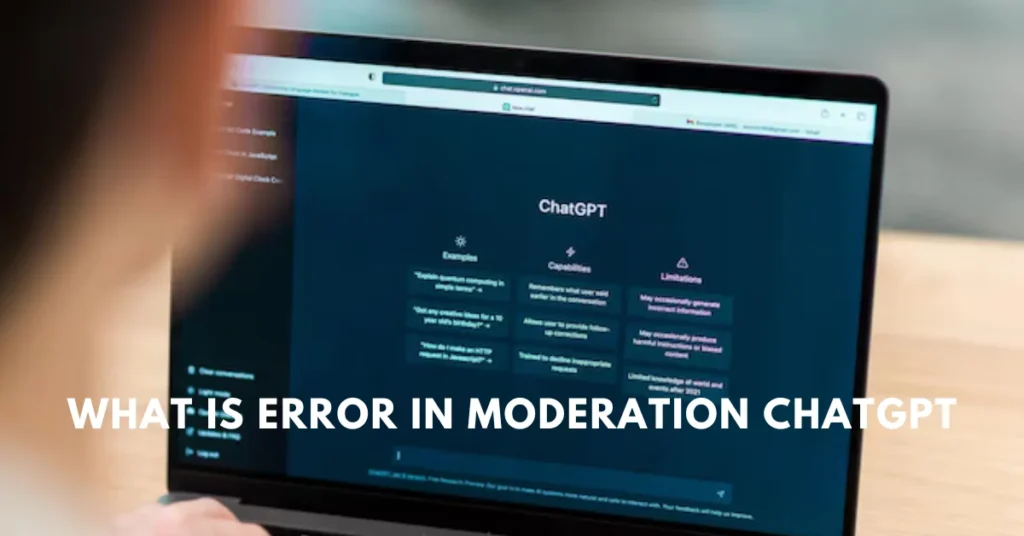Introduction to ChatGPT and Error in Moderation
Artificial Intelligence is reshaping how we interact with technology, and ChatGPT stands at the forefront of this revolution. As a powerful language model, it enables conversations that mimic human-like dialogue. However, like any sophisticated AI tool, it faces challenges in what is error in moderation chatgpt.
One crucial aspect that often goes unnoticed is error in moderation within ChatGPT. What does that mean? Why is it important for both developers and users alike? Understanding these nuances can significantly enhance our experience with AI chatbots.
Join us as we dive into the world of error in moderation related to ChatGPT, exploring its significance and implications for effective communication between humans and machines. Let’s unpack this essential topic together!
The Importance of Error in Moderation for AI Models
Error in moderation is critical for AI models like ChatGPT. It serves as the backbone for ensuring user interactions remain safe and appropriate. Without effective moderation, harmful content can permeate conversations, leading to negative experiences.
Moreover, balancing safety and usability is essential. AI needs to protect users without stifling creativity or free expression. Striking this balance requires ongoing refinement of moderation techniques.
The impact of error in moderation extends beyond individual interactions. It shapes public perception of AI technologies as a whole. Models that consistently fail to moderate effectively risk losing trust from users and stakeholders alike.
In an era where misinformation spreads rapidly, robust error handling becomes even more vital. Effective moderation helps mitigate risks associated with false information while fostering a healthier digital environment for all users involved.
Types of Errors in Moderation – False Positives and False Negatives
Errors in moderation can be categorized primarily into two types: false positives and false negatives.
A false positive occurs when the system incorrectly identifies a harmless piece of content as problematic. This could lead to unnecessary censorship, impacting user experience and limiting freedom of expression. Such errors can frustrate users who feel unjustly penalized for sharing legitimate ideas.
On the flip side, false negatives represent missed opportunities to flag harmful content. Here, the system fails to recognize inappropriate or offensive material, allowing it to slip through the cracks. This may have serious implications, especially if such content spreads misinformation or incites violence.
Both types highlight the delicate balance AI must strike in moderating online interactions. Minimizing these errors is crucial for fostering a healthy digital environment while also respecting individual rights and liberties.
Consequences of Inaccurate Error in Moderation
Inaccurate error moderation can lead to significant repercussions for users and developers alike. When an AI model like ChatGPT misclassifies content, it can either stifle legitimate expression or allow harmful material to slip through the cracks.
A false positive may result in unwarranted censorship. Users could find their posts flagged or removed, leading to frustration and a sense of injustice. This can deter healthy discourse within online communities.
On the other hand, false negatives present equally troubling challenges. Harmful content that goes unchecked can perpetuate misinformation or promote dangerous behaviors. The implications reach beyond individual interactions; they affect public trust in AI systems.
Moreover, businesses relying on these models face reputational risks. A single error might tarnish their image and alienate potential customers who expect responsible moderation practices from technology providers. Balancing accuracy is crucial for maintaining credibility and user satisfaction across platforms.
How ChatGPT’s Error in Moderation Works
ChatGPT’s error in moderation hinges on its ability to analyze and interpret user inputs. It utilizes a combination of natural language processing techniques and machine learning algorithms. These tools help it identify inappropriate or harmful content.
When a message is flagged, the system assesses context, tone, and intent. This evaluation allows ChatGPT to determine if it aligns with community guidelines. However, the intricate nature of human communication poses challenges.
The model may misjudge sentiment or miss subtle nuances in phrasing. A harmless joke could be mistaken for something offensive due to wording alone. Conversely, serious threats might slip through undetected.
Continuous training improves accuracy, but limitations exist within AI comprehension. User feedback also plays a vital role in refining these systems over time. Each interaction serves as an opportunity for growth and better moderation practices.
Challenges and Limitations of Error in Moderation
Error in moderation presents several challenges that impact the effectiveness of AI models like ChatGPT. One major hurdle is context comprehension. AI often struggles to grasp nuances and cultural references, leading to misinterpretation.
Another limitation is the vast diversity of user inputs. Each interaction can vary significantly, making it difficult for algorithms to consistently identify harmful content accurately. This inconsistency can result in erratic performance across different scenarios.
Additionally, training data bias poses a significant challenge. If the datasets used to train these models contain skewed representations or incomplete information, it may lead to incorrect filtering decisions.
Balancing user freedom with safety remains an ongoing dilemma. Striking this balance requires continuous adjustments and improvements in moderation techniques while avoiding overreach that stifles creativity or expression within conversations.
Improving Error in Moderation Techniques for AI Models
Improving error in moderation techniques for AI models requires a multifaceted approach. One effective strategy is enhancing training datasets. By incorporating diverse and representative data, models can learn to differentiate nuances better.
Additionally, continuous feedback loops are vital. Engaging users to report inaccuracies helps refine the model’s understanding over time. This real-world input creates a more adaptable system.
Another avenue involves leveraging advanced machine learning methods like ensemble learning or reinforcement learning. These techniques allow for dynamic adjustments based on performance metrics.
Transparency is key as well; providing insights into how decisions are made fosters trust among users. When people understand the process behind moderation errors, they’re more likely to engage constructively.
Collaboration among researchers and developers can drive innovation in this field. Sharing best practices and findings enables collective progress toward minimizing errors effectively across various platforms.
Conclusion
Understanding what error in moderation means for ChatGPT is crucial for users and developers alike. It influences how the AI interacts with human input, shaping conversations and responses.
By grasping the nuances of false positives and false negatives, we can better appreciate the complexity involved in moderating content effectively. Each type of error carries its own set of consequences that affect user experience, trust, and even safety online.
As AI continues to evolve, addressing challenges in error moderation remains vital. Improved techniques will enhance accuracy while reducing misunderstandings between the model and user intentions.
Navigating this landscape requires ongoing learning. With awareness about these concepts, individuals can utilize ChatGPT more effectively while contributing to a safer digital environment where meaningful interactions thrive.
FAQs
What Is “What Is Error in Moderation ChatGPT”?
Error in moderation within ChatGPT refers to inaccuracies in identifying and managing inappropriate or harmful content during interactions. These errors can be either false positives, where harmless content is mistakenly flagged, or false negatives, where harmful content is missed. Understanding these errors is crucial for improving the reliability and safety of AI-driven conversations.
Why Are Errors in Moderation Important for ChatGPT?
Errors in moderation are important because they directly impact user experience and safety. False positives can lead to unnecessary censorship, frustrating users, while false negatives may allow harmful content to spread. Balancing these errors helps ensure that interactions remain safe without overly restricting freedom of expression.
How Do False Positives and False Negatives Affect ChatGPT’s Performance?
False positives can result in unjustified removal or flagging of harmless content, causing user frustration and limiting legitimate communication. Conversely, false negatives mean that inappropriate or harmful content may not be flagged, potentially allowing it to spread misinformation or incite negative behaviors. Both affect the quality and trustworthiness of ChatGPT’s interactions.
What Are the Challenges in Moderating Content with ChatGPT?
Challenges in moderating content with ChatGPT include understanding context and nuances in language, dealing with diverse user inputs, and overcoming biases in training data. These factors can lead to inconsistent moderation and difficulty in balancing safety with user freedom.
How Can Errors in Moderation Be Improved for AI Models Like ChatGPT?
Improving moderation errors involves enhancing training datasets with diverse and representative information, implementing continuous feedback loops, and using advanced machine learning techniques. Transparency in moderation decisions and collaboration among developers also play key roles in refining the system and reducing errors.







